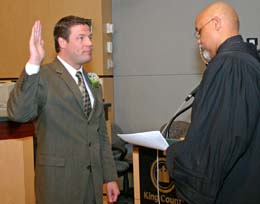On September 20, 2005, four members of the Metropolitan King County Council square off in two contested primaries, one Republican and one Democratic, to decide who will be eliminated from the council. The contests are the result of a County Charter amendment approved by voters in the previous November election, reducing the size of the Council from 13 to nine members. In Council District 9, Reagan Dunn, son of former U.S. Representative Jennifer Dunn (1941-2007), outdistances Councilmember Steve Hammond in the Republican primary. In District 1, Bob Ferguson narrowly defeats Councilmember Carolyn Edmonds in the Democratic primary. Dunn and Ferguson will both win easy victories in the November 2005 general election.
The King County Council had nine members when it was first created by the County's 1968 Home Rule Charter, but was expanded to 13 members as part of 1992 Charter amendments that incorporated the previously independent sewer and transit agency Metro (the Municipality of Metropolitan Seattle) into the King County government. In 2003, the King County Corrections Guild, angered by a 2002 Council budget decision cutting jobs at the county jails, sponsored an initiative to reduce the size of the council back to nine. A challenge to the initiative that went to the state Supreme Court before being rejected delayed the proposed amendment until the 2004 election. There the voters approved it, setting the stage for a controversial redistricting process and contested elections in 2005.
Seven Unopposed
A five-member non-partisan Districting Committee created a district map for the new 9-district Council, announcing the new districts on January 15, 2005. With one member stepping down (Democrat Dwight Pelz made an unsuccessful run for a Seattle City Council seat), the new map placed six of the remaining 12 members in districts of their own, and paired the other six in three districts where two members would have to compete for a single seat.
The six who did not have a fellow incumbent in their districts were Republicans Jane Hague and Pete von Reichbauer and Democrats Larry Phillips (b. 1956), Dow Constantine (b. 1961), Larry Gossett (b. 1945), and Julia Patterson -- all six ran unopposed in the September primary and won easily in the November general election. Republicans Kathy Lambert and David Irons both ended up in the new District 3. However Irons, after contemplating a move to another Council district, ran for County Executive (losing to Ron Sims), so Lambert also retained her seat without opposition.
District 1
That left hotly contested primaries between incumbents in Districts 1 and 9. In District 1, which included northeast Seattle, Shoreline, Lake Forest Park, Bothell, and Kenmore, most Democratic leaders, including County Executive Sims and Seattle Mayor Greg Nickels (b. 1955), supported Carolyn Edmonds, a former state representative elected to the Council in 2001. Bob Ferguson, a self-styled anti-establishment outsider, had won his Council seat in 2003 by defeating Cynthia Sullivan, a longtime leader on the Council, in the Democratic primary.
Ferguson was one of two sitting councilmembers, along with Irons, to support the size-reduction amendment and he, like Irons, saw the new district map pitting them against fellow incumbents as political punishment for that position. Notwithstanding the endorsement of Edmonds by Sims and Nickels, many party activists supported Ferguson and he won the party convention and district endorsements. When all the votes from the September 20, 2005, primary were counted, Ferguson narrowly defeated Edmonds by 52.5 percent (14,157 votes) to 47.5 percent (12,785 votes). Not surprisingly in the heavily Democratic district, Ferguson went on to an easy victory in the November general election.
District 9
The Republican primary in District 9 in the county's rural southeastern region, as in the District 1 Democratic race, featured a councilmember supported by party leaders versus a self-described outsider, but in the Republican race the leaders' choice won. Reagan Dunn had just been appointed to the council earlier in 2005 to replace Rob McKenna, who stepped down when he was elected state Attorney General in the 2004 election. Although he was a newcomer to the council, Dunn's name recognition as the son of former party chair and U.S. Representative Jennifer Dunn (who had named him for President Reagan), gave him a decided advantage in fundraising and endorsements.
Steve Hammond, a former evangelical minister, was appointed to the council in 2003 to replace Kent Pullen, who died in office, and won election that fall to the remainder of Pullen's term. Hammond claimed grassroots support in the rural district, highlighting his attempts to block the County's Critical Areas Ordinance, a land-use measure that many rural residents detested because they saw it as restricting development on their property. (Dunn also promised to reverse the Ordinance.) Dunn ended up spending five times as much as Hammond, and won the seat by 56 percent (11,429 votes) to 44 percent (9,089 votes) in the September 2005 primary. Like Ferguson and their colleagues who had not faced primary challenges, Dunn won easily in the general election.

